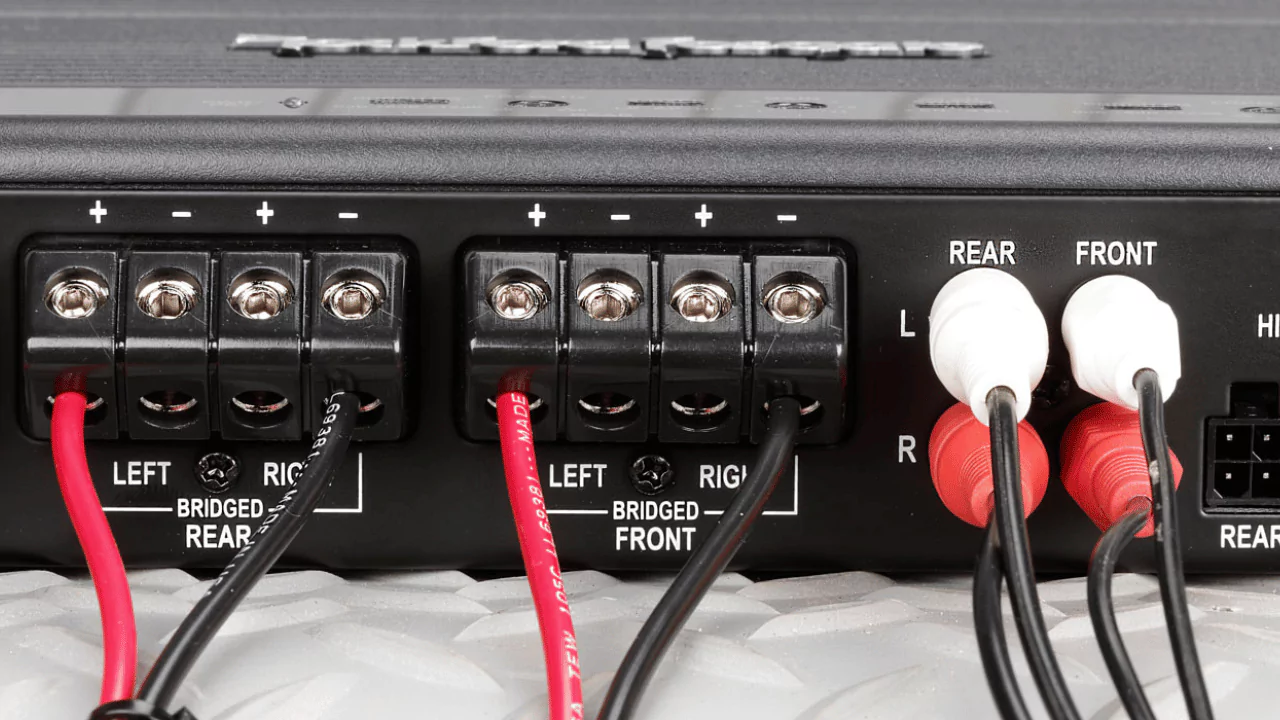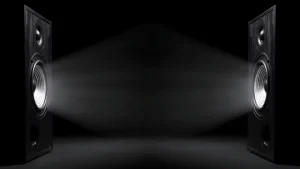Among many other ways of installing a car audio set, bridging a speaker is the simplest process you can apply. To proceed, you have to use four four-channel devices which are compatible with a two or one-channel amplifier. This will help to provide you with the maximum result, and you can get the best output from the system.
However, before you start with the bridging process, you must check that the speakers are getting the requisite power right after the installation so that they can work properly. Also, your amplifier should be compatible with the entire audio setup and accessories.
Without wasting any further time, let’s dive into the step-by-step process of how to bridge speakers.
In This Article:
Components Required to Bridge the Speakers
Before you start to bridge the speakers, you need to check how many channels your amplifier has. Usually, with a two-channel amplifier – you should connect the positive terminal of the wire with the positive terminal of the amplifier’s channel 1. Respectively, connect the negative terminal of the wire with the negative terminal of the amplifier’s channel 2. Next, connect the negative terminal of the amplifier’s channel 1 with the negative terminal of the amplifier’s channel 2.
What are the tools required for bridging a speaker?
Here are the tools that are required to bridge the speakers:
1. Speaker wire
You need speaker wire and also determine the gauge that would be required to connect your speaker to an amplifier and also bridge the equipment. These wires are designed to handle different amounts of impedance and power output. So, you need to choose the correct wire length and gauge to avoid overheating or damaging the device. For example, if you are using a speaker of RMS power up to 500 Watts, then you can use a wire length of up to 4 feet with a wire gauge of 12.
2. Ring terminal
To create a better connection between the speaker and amplifier terminal, you need a ring terminal. These are small metal connectors, so when you attach one end of the wire with these connectors, you can screw the wire directly into the speaker and terminal of the amplifier and avoid the hustle of soldering.
What are the aspects to consider before bridging a speaker?
Here are the tips that you need to follow before you start with the speaker bridging process:
1. Ensure the amplifier you are using allows the bridging
If your amplifier is not compatible with the bridging process and you still try to proceed, then it will increase the power output, which will eventually damage the equipment.
2. Go through the specifications of speaker and amplifier
You must check the power rating for both the speaker and the amplifier and calculate how many watts of power output you would get after you bridge the speaker. This would also ensure that you don’t damage the speaker.
3. Check whether the speaker allows bridging process
You also need to check whether the speakers are compatible with the bridging process and are designed to receive a sudden increase in power. You can go to the manufacturer’s website or check the user manual and then proceed to bridge the speakers.
Step-by-Step Process for Bridge Speakers
Based on the type of amplifier channel-2 or 4, the bridging process differs. So, let’s have a closer look and follow the steps mentioned below:
Step 1. Disconnect the amplifier and wires
Turn off the amplifier and wait for a few minutes after the power is cut. You also need to check that all the components associated with the speaker are disabled. Disconnect the current wring before you start bridging the speakers.
Step 2. Check the impedance
When you bridge the speaker with the amplifier, the impedance will change, so before you start, you must determine the impedance and match the amplifier’s output impedance. This will ensure that after bridging the speakers, there will be no effect on the impedance of the circuit.
When you bridge the speakers, it doubles the voltage as well as the power output, but the impedance is cut in half. So, it is important to check whether the amplifiers are designed to handle the reduction in impedance that comes along with the bridging process.
Check the amplifier’s user manual, and it will help you to understand the impedance that would result from the entire circuit.
Step 3. Check the resulting power output
When you bridge the speaker, the voltage as well as the power output will get doubled, so if the amplifier is delivering 50 W, it will double to 100 W. So, you need to check whether the speaker is compatible with this voltage change. Otherwise, it might damage the speaker, so you must always plan and chalk out the resulting power output before you start the bridging process.
Step 4. Choose the perfect bridging method
There are many ways to bridge a speaker, so you need to determine the best method, and that would depend on how many channels your speaker has. If you are bridging four-channel amplifiers, then the wiring and connection will be different from a two-channel amplifier.
How to bridge a 2-channel amplifier?
Here are the steps that you need to follow:
- Power off and unplug the amplifier from the power outlet and remove the cables connected to the device.
- You will find a switch on the amplifier denoting “Bridge” or “Bridged Mode”. Press it to turn it on, and this button is usually found on the back of the device, or you can also find it on the digital menu of the amplifier.
- Now, connect the positive terminal of the amplifier with the positive terminal of the speaker, and this is for the left channel.
- Again, connect the negative terminal of the amplifier to the negative terminal of the speaker, which is for the right channel.
- Next, connect the negative terminal of the amplifier to the negative terminal of the amplifier with the right output.
- You can also test if you have the right impedance and power output using a multimeter.
- Connect the amplifier to the head unit and also to the power source.
- Turn the volume knob down and slowly increase to test the circuit.
How to bridge a 4-channel amplifier?
When compared with bridging a two-channel amplifier, a 4 channel amplifier seems to be a little complicated.
- Turn off the amplifier and also unplug it from the power outlet.
- Try to locate the “Bridge” or “Bridged Mode” switch on the amplifier, which is usually present at the backside. You can also find it on the digital menu of the amplifier and turn it on.
- Now, check which channels you need to bridge. Usually, channel 1 is bridged with 2, and channel 3 is bridged with 4. This is the most common configuration.
- Connect the speaker’s positive terminal to the amplifier’s channel 1 positive terminal.
- Connect the speaker’s negative terminal with the amplifier’s channel 2 negative terminal.
- Now, coming to the amplifier, connect the negative terminal of channel 1 to the negative terminal 2.
- If you are using two speakers, then you have to repeat the same process for the second speaker as well.
- Next, check the impedance and power output of the circuit using a multimeter.
- Finally, connect your amplifier to the head unit and bring down the volume. Slowly increase the volume after turning on the amplifier.
How to disconnect the speakers?
You must disconnect the speaker before you start bridging the amplifier. So, turn off the head unit, go to the hood of your car, and look for the battery. Disconnect the negative terminal to cut energy to the system and prevent electric shock. Now, unscrew the speaker and pull it out from the mounting. At the back side of the speaker, you will find many wires, which you need to disconnect from your head unit and power source. Also, disconnect the amplifier and follow the steps mentioned above to bridge the speaker. You can power back the system by reconnecting the negative terminal of the battery.
What will happen if you bridge up two speakers?
When you bridge two speakers, it will allow you to power a single speaker using a 2-channel amplifier. You can also use a 2-channel amplifier or opt for a 4-channel amp.
Usually, it is noticed each channel of the amplifier is used to power a single speaker, but after the bridging process is done, the two channels are going to work in harmony, and as a result, you will notice a higher power output.
When should you bridge your speakers?
If the speaker needs more power output as compared to a single channel of your amp, you need to bridge the speakers. Suppose a speaker requires 100 W of power, but the amplifier channel can deliver only 50 W, so if you bridge these two channels, then you will get an output of 100 W.
Is it safe to bridge a speaker or amplifier?
Yes, it is safe but mostly depends on the model of the speaker and what is the power requirement because when you bridge the speaker, the power output doubles, and not all amplifiers are compatible with the bridging process. So, you need to ensure that the amplifier is bridgeable. After you have bridged to the speaker, monitor the amplifier for at least 2 hours and check whether it is getting overheated. If it does, then you need to break the setup.




